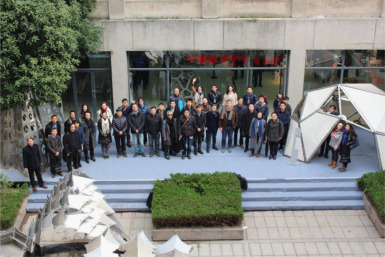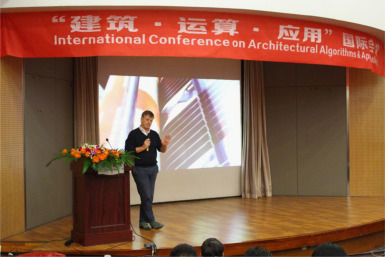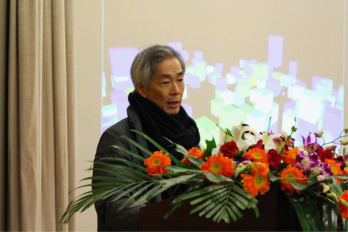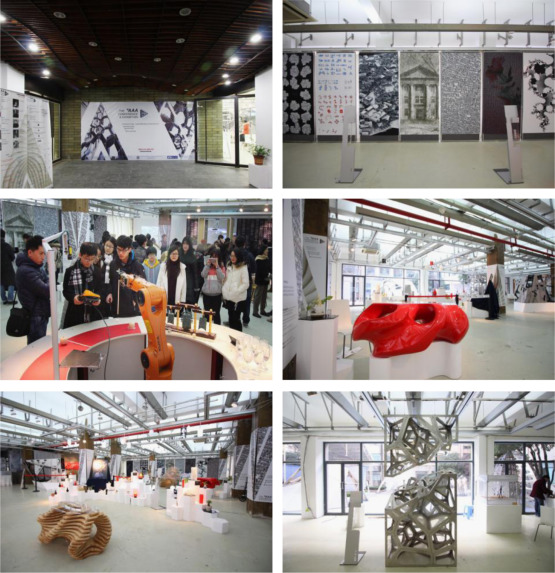Initiated by Prof. Li Biao, the international conference and exhibition on Architectural Algorithms & Applications (the AAA conference) was held on 24–27 November 2016 at Southeast University (SEU). The conference is sponsored by SEU (Nanjing, China) and Swiss Federal Institute of Technology (ETH Zurich). The conference saw a large number of participants from university faculties, students, researchers, and journal editors. Foreign experts from Switzerland and Japan were invited.
The applications of digital technologies in architecture have recently raised sufficient interest from architects. The conference casts a light on the theme “Digital Architecture” which covers three major topics:
- Generative Design. By mimicking nature׳s evolutionary approach to design, generative design starts with predefined design goals and then explores all of the possible permutations to find the best solution.
- Digital Fabrication. It joins design with production through computational design methods and CNC (Computer Numerical Control) manufacturing processes.
- Interactive Design. It builds interactive physical systems that can sense and respond to our physical world and creates adaptive experiences in natural and built environments.
In the morning of November 25, the opening ceremony was held at the School of Architecture, SEU. Prof. Tang Peng hosted the ceremony. The Dean of the School of Architecture SEU, Prof. Han Dongqing, welcomed all the guests and made a brief introduction to the conference & exhibition. The works in the exhibition are created by the Institute of Architectural Algorithms & Applications (Inst. AAA) to illustrate their continuous research on design computation. Prof. Li Biao, the director of Inst. AAA, guided the guests through the exhibition (Fig. 1 ).
|
|
|
Fig. 1. Opening ceremony, the AAA conference & exhibition. |
The conference program featured the presentations of seven experts on digital architectural technologies. The first keynote, Prof. Ludger Hovestadt, holds the Chair of Computer Aided Architectural Design (CAAD) at ETH Zurich. His particular interests lie in the development of design and construction tools capable of managing complex systems with an emphasis on generative design, digital production, and building intelligence. He made the presentation “The limits of social media and how to become a Digital Person” to share his new thinking on architects’ more aggressive roles in the digital era (Fig. 2 ). Prof. Ji Guohua from Nanjing University shared his experiences on digital design and fabrication. In particular, he introduced the algorithmic formulation of Chinese Ice-Ray pattern as a novel connection between generative design and traditional forms. He explored the topic of “Algorithm, Generation & Optimization” in his speech. It׳s a pity that Prof. Christoph Wartmann, CEO of Nexiot AG, was not able to participate in the conference. However, he sent his greetings via video and let Dr. Li Li show his presentation “Startup! From Prototype to Product”. The presentation demonstrated a series of interactive systems and proposed a future perspective of architectural applications.
|
|
|
Fig. 2. Keynotes: Prof. Ludger Hovestadt. |
In the afternoon, the conference continued with Prof. Xu Weiguo׳s (Tsinghua University) presentation titled “Digital Diagram from Bio-Form”. Prof. Xu plays an essential role in introducing digital technologies into China and is a key founder of the Digital Architecture Design Association (DADA) in China. Prof. Makoto Watanabe from Japan made his speech “Can AI make design? (Architectural Intelligence)” with a series of early attempts (since the 1980s) to generate architectural design using computer. He made a deep comparison between human designers and AI (Artificial Intelligence and/or Architectural Intelligence) (Fig. 3 ). Prof. Philip Yuan from Tongji University made recent breakthroughs in applying robotics in building construction. With his presentation “New Materialism YINGZAO”, he discussed the essential roles of digital tools in validating and stimulating novel designs. The host of the AAA conference, Prof. Li Biao, introduced the Rosetta stone of digital architecture in SEU: generative design, digital fabrication, and physical computing. His presentation titled “Decomposition & Integration of Digital Techniques” saw a systematic exploration of the applications of digital technology in architectural design.
|
|
|
Fig. 3. Keynotes: Prof. Makoto Watanabe. |
On November 26, Dr. Hua Hao and Dr. Li Li gave interactive lectures at the exhibition hall. Both speakers are members of Inst. AAA and have organized design studios emphasizing digital technologies. Hua Hao shared his experiences in computational design & fabrication with his lecture “From Algebra to Artifacts”. Li Li introduced his recent developments of wireless networks and discussed with the audience about physical computing in architectural design and education. In the afternoon, the students from ‘Robotic Fabrication’ workshop (tutor: Hua Hao and Prof. Li Biao) presented their works shown at the exhibition. Prof. Xu Zhen and Zhang Xinnan from Tianjin University joined the presentation and gave valuable advice to the students.
The exhibition showed a rich variety of works by the faculty and the students at SEU (Fig. 4 ). Compelling architectural concepts were developed, complex physical models were built and bespoke fabrication processes were engineered. Four interactive installations from the design studio of Prof. Yu Gang and Li Li gained great interest of visits. Dozens of 3D prints show the potential of the integration of coding and additive manufacturing. The Sand Mapper installation combines generative design (automation of site planning and vernacular building design) and responsive technologies (Kinect sensor and a large array of programmable linear units). The robot arm played Chinese chime as a manifestation of the connection between latest robotic technology and the ancient tradition. The exhibition also featured a number of pavilions of distinct materials and assembly methods. The models of three landscape designs at Taihu Lake (Dingshu town) also raised great interest from participants. National academicians Prof. Wang Jianguo and Prof. Zhong Xunzheng joined the exhibition.
|
|
|
Fig. 4. Exhibition hall. |
Based on ten years of continuous research and education in digital architecture, Inst. AAA looks into the future of the digital technologies and methods in architecture and seeks new collaborations with other institutions and organizations. It is hoped that through this academic event, greater interest can be generated for research in computational design & fabrication.
Bringing together leading experts and practitioners, the AAA conference & exhibition proved an excellent opportunity for applying digital technology to various subfields of architectural design. The rapid growth of research in these fields is gradually changing the way people perceive architecture and how we make architecture. The impacts range from the very early stage of conceptual design to construction, and even to the use of the building. Digital technology does not only serve as a tool facilitating various design procedures but also gives birth to unprecedented design theories and methodologies.
Document information
Published on 12/05/17
Submitted on 12/05/17
Licence: Other
Share this document
Keywords
claim authorship
Are you one of the authors of this document?



